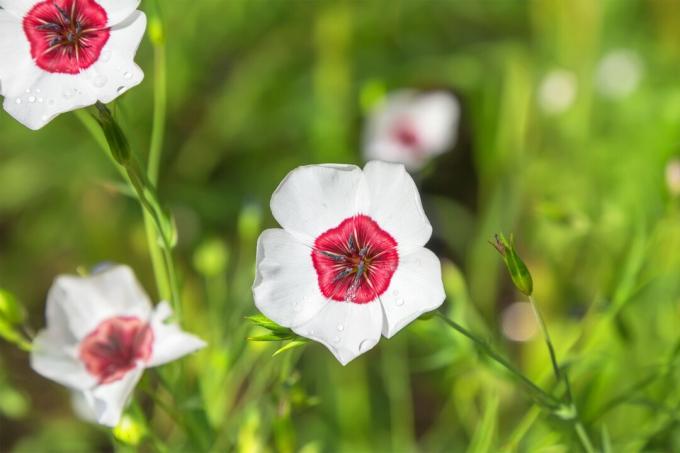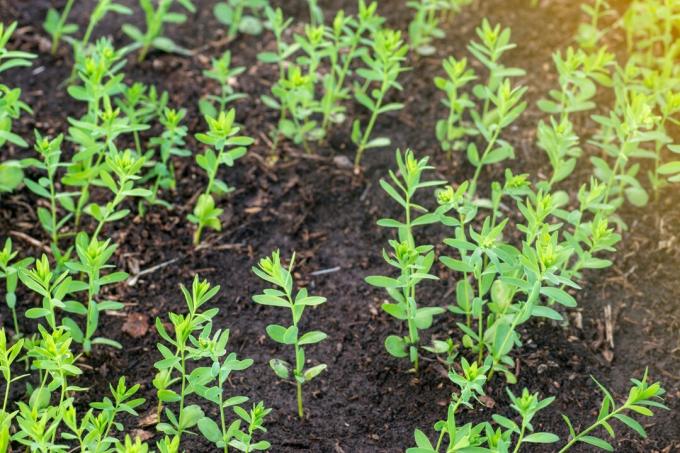The flax is an ancient crop. It is grown as flax, oil flax or for flax seeds. We introduce the flax plant and give tips on choosing a variety, sowing and caring for it.

The common flax (Linum usitatissimum) has been cultivated as a medicinal, fiber and food plant for thousands of years. In this article, you will learn how to plant and successfully cultivate flax seeds in your own garden.
contents
- Flax: origin and characteristics
-
The best types and varieties of flax
- Gold flax (Linum flavum)
-
Common flax (Linum usitatissimum)
- Flax varieties for flaxseed and for oil production:
- Flax varieties for fiber use:
- Purgier flax (Linum catharticum)
- Red flax (Linum grandiflorum)
- Spanish flax (Linum narbonense)
- Perennial flax (Linum perenne)
- Planting flax seeds
- Proper care
Flax: origin and characteristics
Flax belongs to the linaceae family, which includes around 90 different species. These are widespread worldwide, but are particularly found in the Mediterranean region and in the southwest of the USA. The common flax originally comes from Iraq, where it was found around 5000 BC. Chr. was used as a medicinal plant for respiratory diseases. Flax fibers also clad mummies, and fossilized linseed was found in various Egyptian pyramids.
Flax-flax grows into an annual, 50 - 120 cm high, graceful plant with lance-shaped leaves. The radial, five-fold flax seed bloom appears between the end of May and August. It can be colored blue, white or, less often, pink. Flax is predominantly self-pollinating. It is rarely visited by insects because it offers little pollen and nectar. From the pollinated flax flowers roundish and tapering seed pods develop, which consist of five compartments, each with two shiny, egg-shaped, brown or golden colored seeds. These ripen from the end of July to September, while the entire plant increasingly turns brown and dies. Harvest time begins when the seeds begin to rustle in the capsules.

Are flax and flax the same thing? Flax and flax are the same type of plant, just different uses. For flax cultivation, fiber flax (Linum usitatissimum convar. elongatum) utilized. The focus here is on tall, elongated, unbranched plants. Meanwhile, for linseed (Linumusitatissimum convar. mediterraneum) primarily many seed pods with a high oil content are formed.
The best types and varieties of flax
In addition to useful flax, other types of flax can also be planted in the garden. We present the most beautiful types and varieties of flax.
Gold flax (Linum flavum)
The gold flax is a native, perennial flax with light yellow to golden yellow flowers. The plants reach a height of about 30 cm and die above ground in autumn. Gold flax is well hardy, but should be covered with sticks or leaves in very cold areas. At 20 cm, the ‘Compactum‘ variety is a small selection of golden flax.

Common flax (Linum usitatissimum)
When choosing the variety for common flax, the varieties differ depending on the type of use. Flax plants usually grow significantly taller and develop few seeds. Oil-flax varieties develop brown to gold-colored seeds, have a good yield of flaxseed and often have a high content of valuable omega-3 fatty acids.
Flax varieties for flaxseed and for oil production:
- ‘Ingot‘: Flax variety with rather smaller, gold-colored seeds and quite tall plants that remain stable despite the height of growth. Ripening takes place mid-early in August.
- ‘Lirina‘: Oil-rich and high-yielding linseed variety with blue flowers and medium-early ripeness. It has a slight tendency to powdery mildew and is not as stable on heavier soils as other varieties.
- ‘LS Koral‘: Goldlein variety with light yellow seeds and a high oil content. The ripening takes place mid-late from August to September.
- 'Serenade': White flowering linseed variety with high seed yield potential, but lower oil content. The plants only reach a medium height and are therefore well stable.

Flax varieties for fiber use:
- ‘Avian‘: Flax with very good fiber quality and high yields. The early development is rather hesitant and the plants tend to twist more easily in wind and weather than other varieties.
- ‘Felice‘: Variety with very high fiber yield and good disease resistance. The young plants of the ‘Felice‘ variety grow slowly. They are matured in a medium-late stage.
- ‘Lisette‘: Flax variety with rapid development of young plants and medium-late maturity. It is stable, insensitive to most diseases and brings high fiber yields.

Purgier flax (Linum catharticum)
The Purgier or meadow flax is a wild plant that has become indigenous to us and which likes to grow on poor meadows and in flat moors. The delicate 5 - 25 cm high plants form dainty, white flowers and gold-colored seeds.
Red flax (Linum grandiflorum)
Large-flowered, annual flax species with attractive, 3 - 4 cm large flowers and a growth height of up to 40 cm. The red flax originally comes from North Africa and can be planted as a bee pasture. When sown in spring, the flowering period begins as early as June and lasts until October.
- ‘Bright Eyes‘: Extremely attractive, white flowering variety with a red eye. The flowering period extends from June to October.
- ‘Rubrum‘: Classic variety of red flax with large, blood-red flowers.
- ‘Salmon Bright Eyes‘: Long-flowering variety with a height of 40 - 50 cm and salmon-colored flowers with a dark orange center.

Spanish flax (Linum narbonense)
As a perennial, the Spanish flax forms an upright eyrie up to 40 cm high and 30 cm wide with light blue flowers. The plant, which is well tolerated by frost, flowers between June and August.
Perennial flax (Linum perenne)
Perennial flax for sunny, dry locations on humus-sandy and stony soils. The rather short-lived perennial flax forms numerous flowers in summer and multiplies in suitable locations by self-sowing.
- 'Firmament': Perennial blue flax with a height of up to 50 cm. The sky-blue linseed variety blooms between June and August and multiplies by self-sowing.
- ‘Nanum sapphire‘: Compact flax variety with numerous sky-blue flowers on 25 cm high, strongly branched, perennial flax plants.
- ’Nanum Diamond‘: White flax with compact growth up to 25 cm and numerous flowers.

Planting flax seeds
The ideal location for flax is sunny and warm on deep, permeable soils with good water storage. The pH should be between 6.2 and 7 at best. Sandy loam soils are ideal for growing flax. Flax seeds can be grown in beds and as an ornamental plant in pots on the balcony or terrace. The flax seeds are sown directly into the ground between mid-April and the end of May at the latest. The sowing depth is between 1 and 2 cm. The flax should not get deeper into the soil so that germination can take place. At temperatures as low as 3 ° C, germination takes place within 7-14 days. The young plants can withstand short late frosts down to - 4 ° C without damage. The plant spacing is 5 - 10 cm, the row spacing 20 - 30 cm. Approximately 14-20 g of seed are required per square meter. During germination and in the young plant phase, the young flax plants should always be well supplied with water.
Planting flax seeds at a glance
- Optimal location for flax: Sunny and warm on sandy-loamy soils with good water storage.
- Direct sowing from mid-March to early April in fine crumbly soil; Sowing depth: 1 - 2 cm.
- Seed spacing 5 - 10 cm, row spacing 20 - 30 cm; approx. 14 - 20 g flax seeds per square meter.
- Germination takes place at 3 ° C, late frost tolerant down to -4 ° C.
- Water seeds and young plants regularly and keep the soil well moist.
A nutrient-rich potting soil like ours Plantura organic universal soil Not only can it be used for growing flaxseed in pots, it can also help improve heavily sandy or heavy soils. The high compost content promotes root formation, stores excess moisture and releases it to the plant when required.
Flax seeds have a very short growing season. On average, only 100 to 120 days pass between sowing and harvest. Therefore, before and after the flax plant, different types of vegetables such as spinach (Spinacia oleracea), Lamb's lettuce (Valerianella locusta) and radish (Raphanus sativus) are grown as preliminary and subsequent crops. Flax is not self-tolerant and should only be grown on the same bed every six years, otherwise stunted growth and poor yields, so-called "flax fatigue", occur. Fungal diseases that attack the root or shoot, such as Sclerotinia, Fusarium or Phytium, can survive in the soil or be transferred from precultures. Therefore, do not re-sow the flaxseed sunflowers (Helianthus annuus) or pulses (Leguminosae) such as peas (Pisum sativum), Beans (Phaseolus vulgaris) or lenses (Lens culinaris) at.
tip: Flax seeds can be, similar to cress (Lepidium sativum), also cultivate and consume for sprouts. To do this, the seeds are soaked for a few hours in cold water and then germinated on kitchen paper or in a sprout glass or tower.

Proper care
The care of linseed turns out to be quite simple, because the plants are hardly demanding and usually thrive without special attention. However, young flax plants are still not very competitive and can quickly be overgrown by unwanted weeds. Regular weeding and hoeing of the rows is therefore one of the most important maintenance measures until the plants have reached a height of 10-20 cm. The weakly consuming flax usually does not need fertilization on normally supplied garden soils or in nutrient-rich potting soil. The addition of nitrogen can even cause the delicate plants to develop stems that are too soft and bend over in wind and weather. The semen quality and storability also deteriorate with excessive fertilization.
After the flax seeds have been sown and cared for properly, the ripe seeds are harvested in late summer. You can find important tips on this in our article Harvest and use flaxseed.


